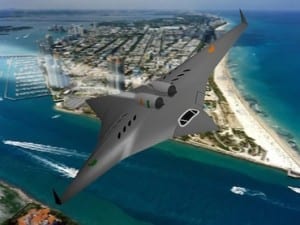Imagine flying from New York to Tokyo in only four hours aboard a fuel-efficient supersonic jet that looks like something right out of Star Wars.
Such a plane could become reality in the next two to three decades, thanks to the efforts of a University of Miami aerospace engineering professor.
Ge-Chen Zha, along with collaborators from Florida State University, is designing a supersonic, bi-directional flying wing (SBiDir-FW) capable of whisking passengers to destinations in significantly less time than it would take conventional aircraft—and without the sonic boom generated by aircraft that break the sound barrier.
The project has just been awarded a $100,000 grant from NASA’s prestigious Innovative Advanced Concepts program, allowing Zha and colleagues to continue development of their high-tech, futuristic plane.
“I am glad that this novel concept is recognized by the technological authorities for its scientific merit,” said Zha, a professor in UM’s College of Engineering and principal investigator of the project. “This prize means that NASA rewards audacious thinking.”
NASA selected Zha’s design and other the projects based on their potential to transform future aerospace missions, enable new capabilities, or significantly alter and improve current approaches to launching, building, and operating aerospace systems.
“These selections represent the best and most creative new ideas for future technologies that have the potential to radically improve how NASA missions explore new frontiers,” said Michael Gazarik, director of NASA’s Space Technology Program. “Through the NASA Innovative Advanced Concepts program, NASA is taking the long-term view of technological investment and the advancement that is essential for accomplishing our missions. We are inventing the ways in which next-generation aircraft and spacecraft will change the world and inspiring Americans to take bold steps.”
With his supersonic bi-directional flying wing, Zha hopes to achieve zero sonic boom, low supersonic wave drag, and low fuel consumption for passenger travel.
“I am hoping to develop an environmentally friendly and economically viable airplane for supersonic civil transport in the next 20 to 30 years,” said Zha. “Imagine flying from New York to Tokyo in four hours instead of 15 hours.”
via University of Miami
The Latest Streaming News: Flying Wing Design updated minute-by-minute
Bookmark this page and come back often
Latest NEWS
Latest VIDEO









